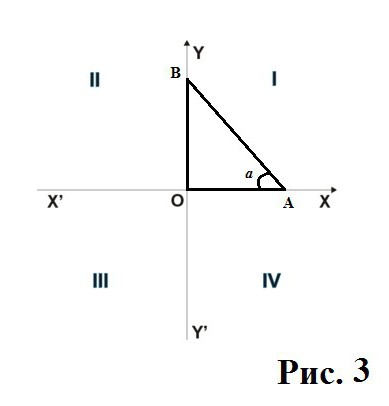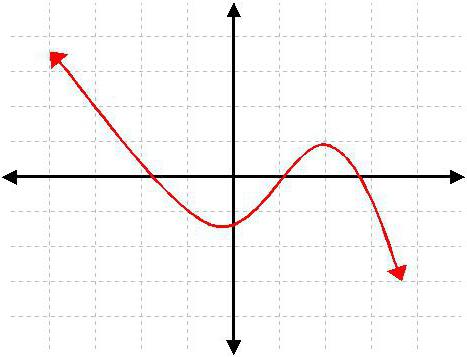In which quarters is the positive cosine? In which quarters is the sine and cosine positive?
Questions arising from the studytrigonometric functions are diverse. Some of them - about which quarter the cosine is positive and negative, in which quarters the sine is positive and negative. Everything is simple, if you know how to calculate the value of these functions in different angles and is familiar with the principle of constructing functions on the graph.
What are the cosine values
If we consider a rectangular triangle, then we have the following aspect ratio, which determines it: the cosine of the angle a is the ratio of the adjacent leg BC to the hypotenuse AB (Figure 1): cos a = BC / AB.

Using the same triangle, one can find the sineangle, tangent and cotangent. The sinus is the ratio of the opposite to the angle of the leg of the AU to the hypotenuse AB. The tangent of the angle is found if the sine of the desired angle is divided by the cosine of the same angle; substituting the corresponding formulas for finding the sine and cosine, we obtain that tg a = AC / BC. Cotangent, as the inverse of the tangent function, will be as follows: ctg a = BC / AC.
That is, for identical values of the angleit was found that in a right-angled triangle the aspect ratio is always the same. It would seem, it became clear where these values come from, but why are negative numbers obtained?
To do this, we must consider a triangle in the Cartesian coordinate system, where both positive and negative values are present.
Visually about a quarter, where is

First quarter

If you place a rectangular triangle in the first quarter (from 0about up to 90about), where the x and y axes have positive values(segments AO and BO lie on the axes where the values have the sign "+"), then the sine that the cosine will also have positive values, and they are assigned a value with the plus sign. But what happens if you move the triangle to the second quarter (from 90about up to 180about)?
Second Quarter

We see that the yoke of the AO has a negative value along the y axis. The cosine of the angle a now has in the ratio of this side to the minus,therefore its final value becomes negative. It turns out that the way in which the cosine of a quarter is positive depends on the location of the triangle in the Cartesian coordinate system. And in this case the cosine of the angle gets a negative value. But for the sine nothing has changed, because to determine its sign you need the side of the OB, which remained in this case with a plus sign. Let's sum up the first two quarters.
To find out in which quarters the cosinepositive, and in which negative (and also the sine and other trigonometric functions), it is necessary to look at what sign is assigned to this or that leg. For the cosine of the angle a The catheter is important for the sine, and for the sinus is the OB.
The first quarter has so far become the only answer to the question: "In which quarters is the sine and cosine positive at the same time?". Let us see further whether there will still be coincidences in the sign of these two functions.
In the second quarter, the AO catheter began to have a negative value, and hence the cosine became negative. A positive value is stored for the sine.
Third quarter

Now both AO and OB axes became negative. Recall the relations for the cosine and the sine:
Cos a = AO / AB;
Sin a = BO / AB.
AB always has a positive sign in thiscoordinate system, since it is not directed to either of the two axes defined by the axes. But the cathets became negative, and therefore the result for both functions is also negative, because if you perform multiplication or division operations with numbers, among which one and only one has a minus sign, the result will also be with this sign.
The result at this stage:
1) In which quarter is the cosine positive? In the first of three.
2) In which quarter is the sine positive? In the first and second of three.
Fourth Quarter (from 270about up to 360about)

Here, the company's cat is again acquiring the plus sign, and hence the cosine, too.
For the sinus, the cases are still "negative", because the catheter's OM remained below the initial point O.
conclusions
In order to understand in which quarterscosine positive, negative, etc., you need to remember the ratio to calculate the cosine: adjacent to the angle of the cathetus, divided by the hypotenuse. Some teachers offer to remember this: to (aspen) = (k) corner. If you remember this "cheat", then you automatically understand that the sine is the ratio of the opposite to the angle of the leg to the hypotenuse.
Remember in which quarter the cosinepositive, and in which it is negative, it is rather difficult. Trigonometric functions are many, and all of them have their own meanings. But still, as a result: positive values for the sine - 1, 2 quarters (from 0about up to 180about); for the cosine of 1, 4 quarters (from 0about up to 90about and from 270about up to 360about). In the remaining quarters, the functions have a minus sign.
Perhaps, it will be easier for someone to remember where the sign is, according to the image of the function.

For the sine it is evident that from zero to 180about The crest is above the line of sin (x) values,hence the function is positive. For the cosine, also: in which quarter is the cosine positive (photo 7), and to which negative is the displacement of the line above and under the cos (x) axis. As a result, we can remember two ways of determining the sign of the sine, cosine functions:
1. On the imaginary circle with a radius equal to one (although, in fact, it does not matter what radius is in the circle, but in textbooks most often this is the example; it facilitates perception, but at the same time, if not to stipulate that this is not the essence it is important that children can get confused).
2. From the depiction of the dependence of the function on (x) on the argument x itself, as in the last figure.
With the help of the first method, you can UNDERSTAND, from whichit depends on the sign, and we explained it in detail above. Figure 7, constructed from this data, perfectly visualizes the resulting function and its familiarity.
</ p>>







